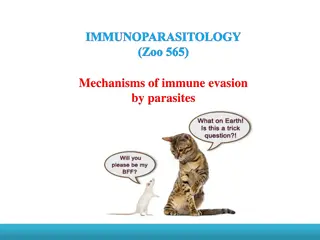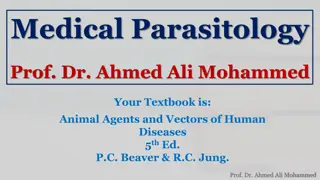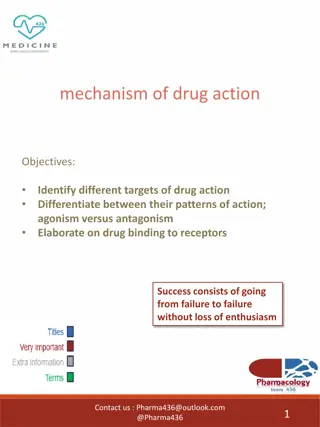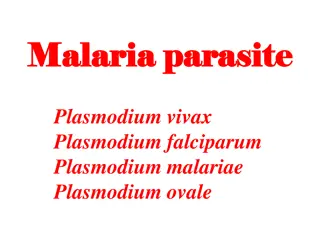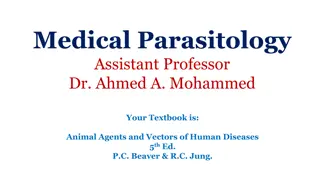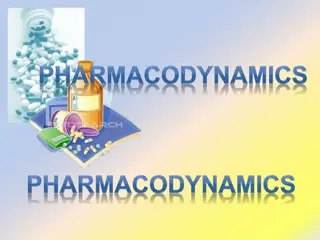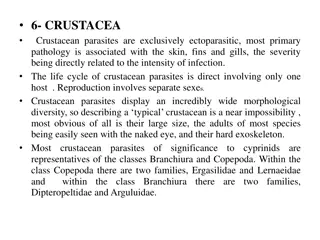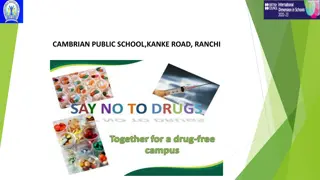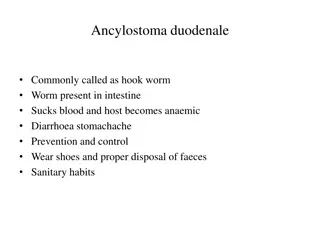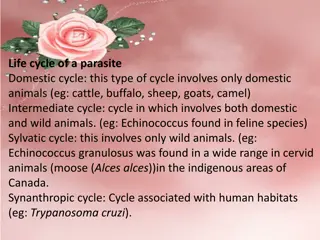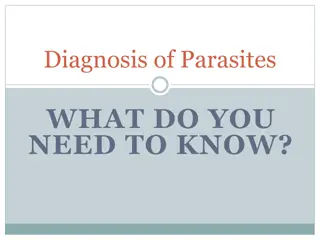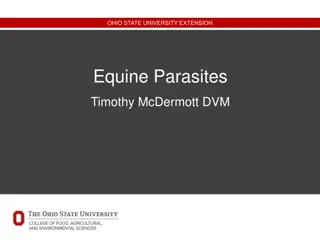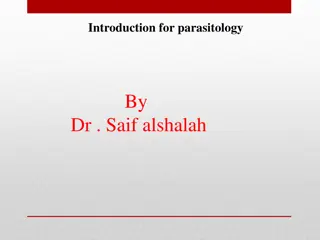Understanding Biochemical Mechanisms of Drug Action Against Parasites
Parasitic protozoa cause devastating diseases in humans and animals, and chemotherapy is the primary defense. Drug resistance is a challenge, and prevention is crucial. Modern tools aid in studying genetic and biochemical aspects, targeting the parasite selectively. Drugs act by interfering with specific processes, showing selective toxicity. This article delves into the intricacies of drug action against parasitic protozoa.
Download Presentation

Please find below an Image/Link to download the presentation.
The content on the website is provided AS IS for your information and personal use only. It may not be sold, licensed, or shared on other websites without obtaining consent from the author. Download presentation by click this link. If you encounter any issues during the download, it is possible that the publisher has removed the file from their server.
E N D
Presentation Transcript
BIOCHEMISTRY OF PARASITES BCH 4I4 LECTURE 6 Biochemical mechanism of drug action against parasite PART 1 S.O Anadozie (Ph.D.)
Introduction Parasitic protozoa are responsible for some of the most devastating and prevalent diseases of humans and domestic animals. These includes malaria (Plasmodium spp.), (muco)cutaneous and visceral leishmaniasis (Leishmania spp.), African sleeping sickness (Trypanosoma brucei gambiense, T'ypanosoma brucei rhodesiense), Chagas' disease (Trypanosoma cruzi), amoebic dysentery (Entamoeba spp.), and toxoplasmosis (Toxoplasma spp.) Prevention is likely the most efficient way to control parasitic protozoa.
Introduction (CTD) Till date no effective vaccines against any of the main parasites. Chemotherapy is the main line of defence against parasitic protozoan infections in both humans and domestic animals. The success of chemotherapy depends on the ability to exploit metabolic differences between the pathogen and the host, and the environment in which they live. American trypanosomes can still not be effectively and safely managed by chemotherapy. The chemotherapeutics used to manage these parasitic protozoan infections are limited in usage because most of these parasites have form resistance to these drugs e.g. chloroquine in malaria and metronidazole in anaerobic parasites.
Introduction (CTD) Prevention and circumvention of drug resistance are medical and veterinary priorities. Modern tools both in pharmaceuticals and by vertinaries are used to circumvent This advanced method permits direct studies of the basic genetic development, biochemical and biological nature of pathogenic parasites. Also, allow the identification and appropriate molecular target for selective therapeutic attack / toxicity for the pathogen as compared to the host. And the ability to elucidate the molecular mechanism of drug action and resistance. Protozoa are eukaryotes and usually contain many of the organelles and metabolic pathways of their hosts.
Drug Action (resistance in parasitic protozoa) Drugs act by specifically interfering with cellular or biochemical processes, often called 'targets'. E.g. an enzyme which is inhibited by the drug. Selective toxicity for the pathogen as compared to the host. Drugs highly toxic to the pathogen and at the same time exhibit minimal toxicity to the host. Unique target in parasite. Target more important to parasite than host. Greater drug accumulation by parasite Drug activation by parasite
Drug Action (resistance in parasitic protozoa) (CTD) To interfere with parasite multiplication, a drug must find the parasite (often in a host cell) and reach its target within the parasite. This is done by allowing the drug to pass the parasite membrane, and get activated inside. After the drug hits the target, the parasite must be sufficiently incapacitated to be killed by the host defence or to die spontaneously. This allows the parasite the opportunities to interfere with drug action, resulting in drug resistance.
Drug Action (resistance in parasitic protozoa) (CTD) Resistance in clinical samples is less easily defined in biochemical terms and the mechanisms are most easily studied in parasites made resistant in the laboratory. Genetically defined experiment can be done by cloning populations, and comparing the resistant mutants and the parental strain from which they were derived, to find the gene(s) involved in resistance. However, parasite populations are often heterogeneous, the exact parental strain is often not available for comparison, and the culturing of the parasites often necessary to get sufficient material for analysis may change resistance. Polymerase chain reaction (PCR) and monoclonal antibodies allow the study of genes and proteins in a few cells.
Drug Action (resistance in parasitic protozoa) (CTD) Cell may learn to live with a blocked target by bypassing the block. Parasitic protozoa are using most of these strategies to achieve resistance. Studies of resistance mechanisms can help by developing tools to recognize resistance early in infection and prevent useless and often toxic chemotherapy. Rational use of drugs and drug combinations minimize development of resistance. Pinpointing intracellular drug targets and defence mechanisms allows the development of drug analogues that evade the most common defences.
Drug Action (resistance in parasitic protozoa) (CTD) Fig.1: Biochemical mechanisms of drug resistance
Drug Action (resistance in parasitic protozoa) (CTD) General biochemical framework of resistance is often similar. Cells may evade drug action by hiding in sanctuaries such as the brain . Drug uptake may be thwarted by loss of uptake systems or alteration of membrane composition. Once inside, drugs may be inactivated, excreted, modified and excreted, or routed into vacuoles. Drug activation mechanisms may be suppressed or lost. Interaction of drug with target may be made less effective by increasing the level of competing substrates or by altering the target to make it less sensitive to the drug.
Classification of anti-parasitic agents and their mechanism of action Chloroquine: Efflux (protonation of ions), modulation of parasite transporters and binding to specific receptors. This is achieved by exerting toxic effect of the drug by interfering with the conversion of free heme to hemozoin. Antifolates and sulphonamides: Acts by target modification or via by-pass mechanism or modification of drug.. Antimony: Drug modification, sequestration or by active efflux Arsenical: Reduced uptake Pentamidine: Reduced uptake Eflornithine: Enzyme turnover or substrate modification Benzimidazole: Target modification Ivermectin: Efllux
Drug resistance in malaria Malaria is one of the main public health problems worldwide. Chloroquine has long been the drug of choice for treating malaria, however, resistance to chloroquine is widespread in every geographical region in which malaria is endemic. More extensive use of antifolates but resistance to this second line of treatment appeared very rapidly. The reduced efficacy of chloroquine and antifolate based chemotherapy has led to the increased use of mefloquine and artemisinin. In countries like Africa, Plasmodium falciparum, the agent responsible for the most severe form of malaria, has become resistant to almost all antimalarial agents
Chloroquine mechanism and resistance Chloroquine accumulates in the food vacuole of the parasite and inhibits polymerization of the toxic heme that is released during haemoglobin degradation within the digestive vacuole of the parasite. The accumulation involve ion trapping following protonation, specific transport, and/or binding to a receptor (eg., heme). Resistance to chloroquine results from a decreased accumulation of chloroquine in the food vacuole, similar to phenotypic features with multidrug resistance (MDR) of mammalian tumour cell lines. Chloroquine efflux is increased in resistant parasites and verapamil, the classical agent to reverse MDR in animal cells, can restore chloroquine sensitivity in resistant cells. Two different transporters (CRT and MDR1) have been implicated in resistance.
Chloroquine mechanism and resistance Fig.2. Chloroquine mechanism uptake in the food vacuole
Reviews And Questions Engage in further reading Thank you




